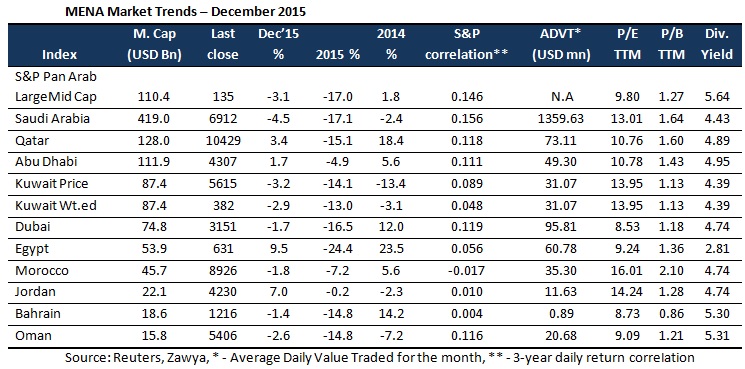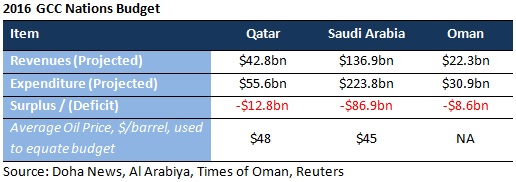
Kuwait Financial Centre “Markaz” recently released its Monthly Market Research report. In this report, Markaz examines and analyzes the performance of equity markets in the MENA region as well as the global equity markets for the month of December.
Most MENA markets ended in red during the month of December 2015, with Saudi Arabia (-4.5%) declining the most, followed by Kuwait price (-3.2%) and weighted (-2.9%) indices. Decline in oil price by over 16% during the month and declaration of deficit laden budgets has led to the regional market response. Saudi markets fell the most slipping on oil and after the release of its 2016 budget, which forecasted a cut in spending and a deficit of $87bn. Speculation about other possible measures including possible subsidy and tax reforms, also weighed in on the markets.
For the year 2015, Egypt declined 24%, due to faltering reforms and forex shortage, while Tadawul’s TASI index declined 17%. All MENA indices ended in red for the year 2015, with most witnessing double digit declines. Oil price fall, regional and global political developments, the recent Fed hike, and Eurozone woes were the much spoken themes for the year. S&P GCC declined 2.4% in December, making it a cumulative decline of 17.4% for 2015.
MENA markets liquidity continued its momentum in December, with volume increasing by 4% and value traded by 14.1%. With the exception of Bahrain, Kuwait, Qatar and Abu Dhabi, other MENA markets witnessed rise in market liquidity, with Morocco, Oman and Jordan leading the charge. Morocco showed the most improvement with value traded increasing by 388% and volume traded increasing by 360%. Overall MENA liquidity for the year was down 30% compared to previous year, with $559bn value traded in 2015.
Qatari companies had a reversal of fortunes this month, with Ooredoo (Qatar) gaining 13.6% in December, followed by Industries Qatar (Qatar) and QNB (Qatar), which gained 10.5% and 9.4%, respectively. Ooredoo had a busy month, signing a MoU with Qatar Airways for onboard Wi-Fi, achieving speeds up to 375Mbps with the launch of LTE-Advanced (LTE-A), expanding services to Maldives and announcing investments in Data Centre Solutions. QNB acquired Turkey’s Finansbank for $2.94bn in the month, one of the largest takeovers to date by a GCC lender outside its domestic market. Fall in oil price affected SABIC’s fortunes in the market (-14.5%), as the company slipped the most in the month, followed by Kuwait Food (-11.5%) and Emirates NBD (-7.5%). Emirates Telecom was the top performer in 2015, gaining 61.7%, as the company recuperated from the accounting scandal that affected performance in 2014.
Qatar’s 2016 budget, which includes cut in expenditures in anticipation of the country’s first fiscal shortfall in 15 years, was released on 16th December 2015. Expenditures are forecasted at $55.6bn next year, which is a 7.3% decline from the last fiscal year, despite the increase in outlays on government salaries, wages and major projects – such as major transportation initiatives and preparations for the 2022 World Cup. Saudi Arabia unveiled a $223.8bn budget, as the Kingdom attempts to further diversify its revenues in an era of low oil prices. The government incurred a deficit of $97.9bn (15% of GDP in 2015), and with the 2016 budget it aims to cut that to $86.9bn. Spending has been forecasted to decline to $224bn, down from the $260bn actually spent in 2015. Efforts are being undertaken to ensure government projects are more efficient, necessary and affordable. Omani government expenditures and revenues for 2016 are estimated at $30.9bn and $22.3bn, respectively, leading to an estimated deficit of $8.6bn, lesser than the $11.7bn deficit expected for 2015. The expenditures for 2016 are 15.6% less than in 2015 ($36.6bn), while revenue estimates declined by 25.86%, compared to the previous year’s $30.1bn.
Threat of new sanctions over Iran did little to stem the oil price slide, as Brent crude price dropped 16.4% in Dec’15, extending the overall annual loss to 35%, and closing the year at $37 per barrel. This reflects a drop of 68% since the highs seen in Jun’14 ($115 per barrel). With production in US and OPEC growing over the last few months, the supply glut could take a while to clear. Brimming oil inventories across the globe implies low oil prices in the near- to medium-term.


About Kuwait Financial Centre “Markaz”
Kuwait Financial Centre K.P.S.C “Markaz”, established in 1974, is one of the leading asset management and investment banking institutions in the Arabian Gulf Region with total assets under management (AUM) of KD 1.05 billion as of September 30th, 2015 (USD 3.47 billion). Markaz was listed on the Kuwait Stock Exchange (KSE) in 1997.
For further information, please contact:
Alrazi Al Budaiwi
Media and Communication
Kuwait Financial Centre K.P.S.C "Markaz"
Tel: +965 2224 8000 ext. 1800
Fax: +965 2249 8740
Email: [email protected]
Url: www.markaz.com

